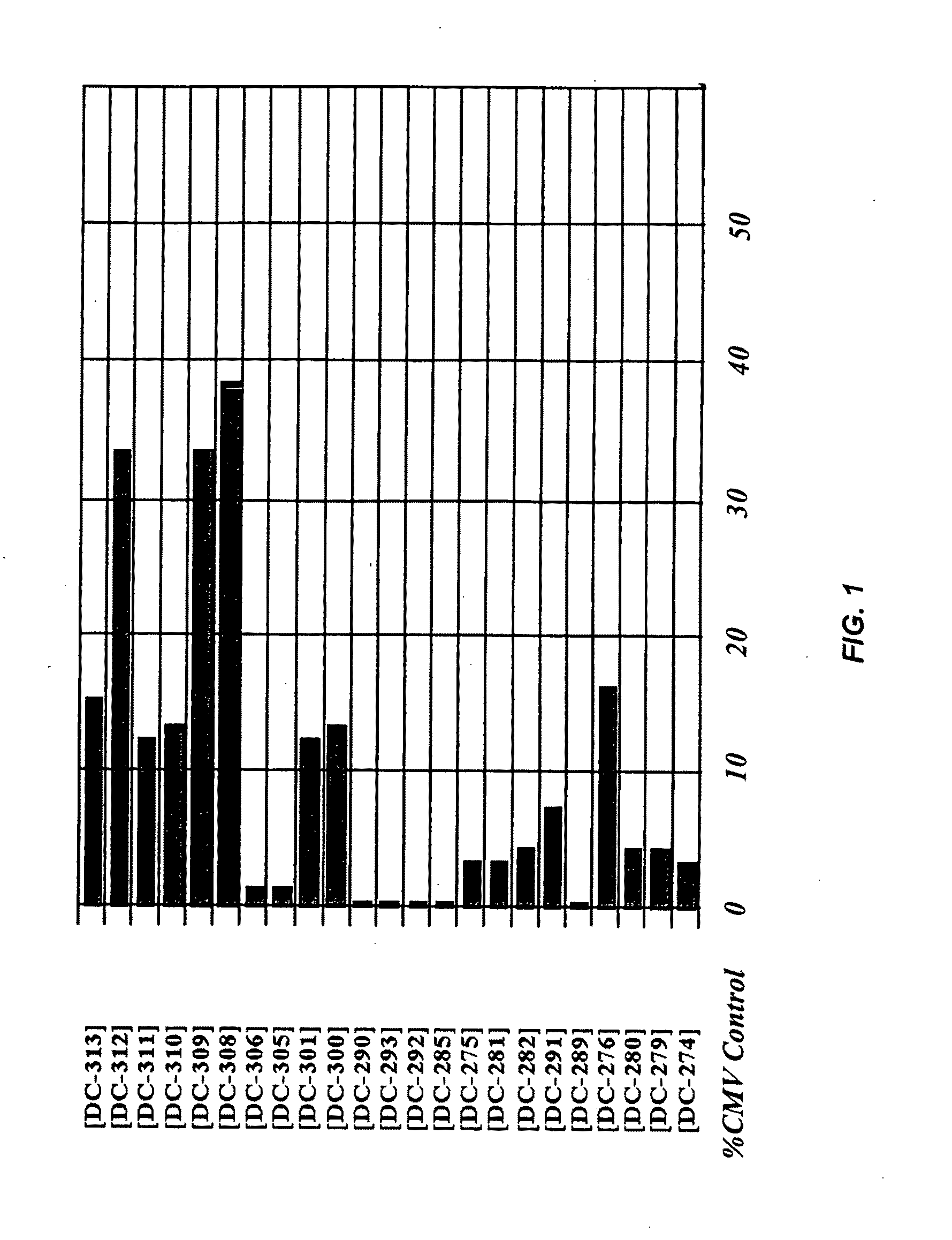Muscle-specific expression vectors
a tissue-specific and expression-based technology, applied in the direction of metabolism disorders, extracellular fluid disorders, peptide/protein ingredients, etc., can solve the problems of limiting the effectiveness of viral vectors, poor in vitro delivery of these vectors, and generally too low levels of gene transfer to be sufficient for clinical applications
- Summary
- Abstract
- Description
- Claims
- Application Information
AI Technical Summary
Problems solved by technology
Method used
Image
Examples
example 1
Vector Construction
[0062]Restriction enzymes, T4 DNA ligase, DNA polymerase I and large fragment (Klenow) were purchased from New England BioLabs (Beverly, Mass.).
[0063]Mouse and human genomic DNA was obtained from Clontech (Palo Alto, Calif.). PCR-amplification of regulatory elements from genomic DNA was performed with VentR® DNA polymerase (New England BioLabs, Beverly, Mass.) using primers as indicated in the Detailed Description of Invention as follows: 1 cycle of 4 min at 94° C., 2 min at 45° C., and 5 min at 68° C. with 34 cycles of 1 min at 94° C., 2 min at 55° C., and 5 min at 68° C. SV72 enhancer element containing a 72-bp repeat from the simian virus 40 (SV40) enhancer is described in Li et al., Gene Therapy 2001, 8: 494-497. DNA restriction fragments to be cloned into phagemid or plasmid vectors were isolated from agarose gels using DEAE paper and cloned as described in Sambrook et al., Molecular Cloning: A Laboratory Manual, 2nd Ed., Cold Spring Harbor Laboratory Press, ...
example 2
Short-Term Expression in Mice
[0068]BALB / C mice were injected with 50 μg test plasmid in 50 μl of phosphate-buffered saline (PBS) into the anterior tibialis. Five mice were used for each test plasmid or the control group. A plasmid containing a CMV promoter / enhancer (−1 to −522) as described in Li et al., Gene Therapy 2001, 8: 494-497, was used in the control animals.
[0069]The overall efficiency of transfection was evaluated by measuring the concentration of SEAP in the serum of animals. Blood was collected intraorbitally at 7 days post-injection. The serum was heated to 65° C. to denature endogenous alkaline phosphatase and assayed for SEAP activity per manufacturer's instructions using an alkaline phosphatase reagent from Sigma-Aldrich (St. Louis, Mo.) and human placental alkaline phosphatase from Calbiochem (LaJolla, Calif.) as a standard. The observed SEAP expression levels were normalized as a percentage of the CMV control.
[0070]SEAP expression levels of various promoter / enhance...
example 3
Long-Term Expression in Rats
[0071]To investigate persistence of expression in various enhancer / promoter combinations, Sprague Dawley rats were injected into iliac vein with 500 μg test plasmid in 500 μl of phosphate-buffered saline (PBS). Five rats were used for each test plasmid or a control group. A plasmid containing a CMV promoter / enhancer (−1 to −522) as described in Li et al., Gene Therapy 2001, 8: 494-497 was used in control animals. Blood was collected at 1, 7, and 21 days post-injection, and the serum was assayed for SEAP activity as described in Example 1.
[0072]Comparisons of SEAP expression levels among various promoter / enhancer chimeras were made. The SEAP expression levels, calculated as a mean of each group, are presented in FIG. 2 and, in a tabulated form, in Table 2. As is demonstrated, comparable SEAP expression levels to the CMV control were achieved by day 7 in all chimeras tested but, by day 21, DC-301 demonstrated the greatest expression persistence. With DC-308...
PUM
| Property | Measurement | Unit |
|---|---|---|
| alkaline phosphatase | aaaaa | aaaaa |
| distance | aaaaa | aaaaa |
| fibrillary acidic protein | aaaaa | aaaaa |
Abstract
Description
Claims
Application Information
 Login to View More
Login to View More - R&D
- Intellectual Property
- Life Sciences
- Materials
- Tech Scout
- Unparalleled Data Quality
- Higher Quality Content
- 60% Fewer Hallucinations
Browse by: Latest US Patents, China's latest patents, Technical Efficacy Thesaurus, Application Domain, Technology Topic, Popular Technical Reports.
© 2025 PatSnap. All rights reserved.Legal|Privacy policy|Modern Slavery Act Transparency Statement|Sitemap|About US| Contact US: help@patsnap.com


